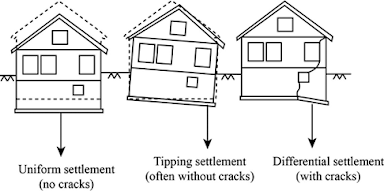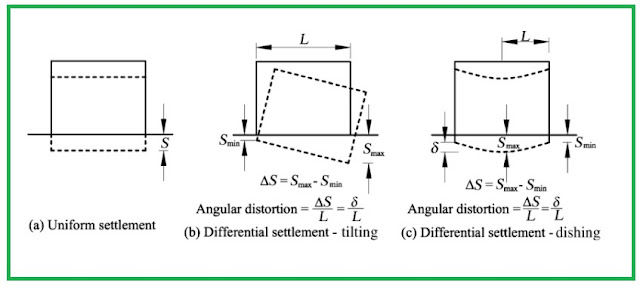Search This Blog
Most Popular
What is a Transfer Beam?
May 27, 2020
Categories
- Building Construction (83)
- Building Materials (82)
- Columns (2)
- Concrete Beam (3)
- Concrete Construction Techniques (4)
- Concrete Mix Design (10)
- Concrete Repair (14)
- Concrete Slab (10)
- Construction Equipment (16)
- Construction News (7)
- Design of Structures (15)
- Engineering Drawing (1)
- Estimation (3)
- Geotechnical engineering (26)
- Highway Engineering (11)
- Innovations (30)
- Material Testing (9)
- Matrix Analysis of Structures (2)
- Mechanical Engineering (3)
- Strength of Materials (2)
- Structural Analysis (17)
- Structural Design (21)
- Structures (17)
- Transportation Engineering (9)
Foundation Settlement: A Comprehensive Guide to Causes, Repair Methods, and Types
Neenu
January 26, 2023
Foundation settlement is the downward vertical movement of the foundation caused by the displacement of the surrounding soil. It is a geotechnical settlement that typically occurs as a result of loads (building, vehicles, etc) that exceeds the underlying soil-bearing capacity.
Read On: Horizontal Cracks in Foundation
Foundation Design: Theory and Practice, By N. S. V. Kamesware Rao
 |
| Image Credits: Dry Pro |
Foundation settlement is caused due to geotechnical or soil settlement which is observed commonly in weak and poorly compacted soil. Many environmental conditions and construction practices can be the major cause of creating soil with poor bearing capacity.
Soil settlement results in settlement cracks in the foundation that requires professional repair solutions for the safety and durability of the structure.
This guide explains the foundation settlement in geotechnical engineering, outlining its causes, components, and types.
No Time to Read?? Watch Video
Total Settlement of Foundation - Components of Foundation Settlement
When the load (any structure or foundation) comes over a soil mass, three types of soil settlement is ought to occur. These settlement occurs at different time periods during the life of the structure and their sum forms the total settlement of the foundation. The components of soil settlement are:
- Immediate settlement or elastic Settlement (Si)
- Consolidation settlement or primary settlement (Sc)
- Creep settlement or secondary settlement (Ss)
1. Immediate Settlement or Elastic Settlement or Distortion Settlement
Immediate settlement of the soil occurs as soon as a load (foundation) is applied over the soil, i.e. immediately after the construction of the structure due to the distortion ( change of shape and not the volume) of foundation soils. Here, the load on the soil results in the expulsion of air from the soil voids causing elastic compression. This process rearranges the soil particles and causes immediate settlement.
Immediate settlement is calculated using elastic theory ( even though it is not truly elastic in nature), especially for cohesive soils.
2. Consolidation Settlement or Primary Settlement (Sc)
Consolidation settlement occurs when the water present in the soil voids gets squeezed out over time. The process reduces the void spaces that rearrange the soil particles. This makes the soil move downwards. It is determined using Terzaghi's theory of consolidation.
3. Creep Settlement or Secondary Settlement (Ss)
Creep settlement or secondary settlement begins after the completion of consolidation settlement. This component of creep settlement occurs throughout the life period of the soil as long as it is subjected to a constant pressure of the load.
Creep settlement in a foundation is calculated from the coefficient of secondary consolidation. It varies based on the:
- Type of soil
- Anisotropy
- Stress history of soil
- The stress level on the ground
Hence, the total settlement S is given by
S = Si + Sc + Ss
The sources of settlement vary based on the type of soil. The table below shows different soil types and what type of settlement is ought to occur.
 |
Sources of Settlement of Foundations Image Credits: The Engineering of Foundations, Slopes and Retaining StructuresBy Rodrigo Salgado |
What are the Types of Foundation Settlement?
The displacement of soil leads to foundation settlement. The downward vertical settlement of the foundation can be uniform or differential. Hence, before understanding the causes of foundation settlement, we need to understand that there are two types of foundation settlement:
- Uniform foundation settlement
- Differential foundation settlement
 |
| Fig.2. Types of Foundation Settlement |
1. Uniform Foundation Settlement
Uniform foundation settlement occurs when all the section of a structure undergoes the same rate of settling. (Figure 3(a))
Uniform foundation settlement is likely to occur, when
- The entire portion of the foundation lies on the same kind of soil
- The loads on the structure are uniform throughout
Compared to other types of foundation settlement ( differential & curvature settlement), uniform foundation settlement is normal and typically causes less structural damage.
However, uniform settlement influences the underground building utilities like sewer, water supply, and jamming of doors and windows.
2. Differential Foundation Settlement
When every portion of the structure on the ground does not undergo settlement at the same rate, differential foundation settlement occurs. Here, different parts of the building structure settles at different settlement values.
As shown in figure 3(b,c) if one part of the structure settles differentially with respect to other parts of the foundation, the structure undergoes distortion. The connecting beams, slabs, and interfaces may crack and the floors become unusable.
Figure-x(b) shows a uniform tilt, where the entire structure is subjected to rotation. Figure-x(c) shows a non-uniform tilting also called dishing or curvature settlement.
 |
| Fig.3. Uniform and Differential Foundation Settlement Image Credits: Foundation Design: Theory and Practice, By N. S. V. Kamesware Rao |
Both these types of differential settlement are caused due to non-uniform settlement that is caused due to:
- Non-uniform bearing stress
- Non-homogeneous subsoil conditions
As shown in the figure above, the differential settlement (Δs)between two points is the larger settlement minus the smaller one. It is also characterized by angular distortion which is determined as the ratio of differential settlement between two points and the horizontal distance between them (δ/L).
Differential settlement results in cracks in building walls distorts the structure, floors might slope, and difficulty opening and closing windows or doors.
Major foundation failures are caused due to differential settlement and hence it is a very critical issue during the design and construction of a building structure.
Chances for the occurrence of differential settlement on a site in the future are forecasted by adequate ground investigation and correct interpretation of soil data which is gathered from geotechnical tests conducted.
What Causes Foundation Settlement?
Foundation settlement can be caused due to many direct and indirect reasons. As we outlined before, uniform foundation settlement is less detrimental while differential settlement is a big concern.
Every differential foundation settlement issue hence has an underlying root cause that needs to be studied by a foundation repair contractor before coming up with a solution.
The major causes of foundation settlement are:
- Improper Preparation of Soil for Construction: Before exposing the soil to any structural load, it is a compulsory construction practice to properly prepare the soil, compact it and prepare for the estimated expected load.
- Improper Compaction of Soil: To prepare the soil for better bearing capacity, additional soil filling and compaction are performed for a better foundation subgrade. Failing to do this results in foundation settlement.
- Incorrect Estimation of Soil Bearing Capacity: To what extent a particular soil requires preparation is dependent on the current soil bearing capacity. Wrong estimation of soil-bearing capacity results in errors in the proper preparation of soil which causes foundation settlement.
- Low Bearing Capacity of Soil: Lower the bearing capacity of the soil, the higher the chances for foundation settlement, irrespective of what causes a low value of bearing capacity.
- Expansive Soil: Expansive soils are those soil that expands and shrinks considerably as seasons alternate between wet and dry. If a foundation has expansive soil below it and does not expand or shrink uniformly, the movement in the foundation does not become uniform. This causes stress on the foundation which could lead to structural damage.
- Construction Activities: Excessive vibration or excavation activities performed near an existing foundation results in the underlying soil becoming loose support. This could eventually cause differential settlement.
- Natural Calamities: Natural calamities like earthquake, and floods tremendously affects the stress conditions of the soil underlying the foundation.
Repair of Foundation Settlement
All structures experience foundation settlement over years. Foundation settlement is negligible as long the settlement value is minimal and uniform throughout the structure. The most prominent method of foundation repair is underpinning and proven to provide better durability.
The sinking of the foundation by 2 inches or more will ask us to contact a Foundation repair contractor. He mainly undergoes an underpinning process in order to repair the settled foundation.
Here are some of the most common methods to repair foundation settlement:
Here are some of the most common methods to repair foundation settlement:
- Mudjacking: Mudjacking is a process where a mixture of water, cement, and soil is injected beneath the foundation to lift and level it. This method is suitable for minor settlement issues, and it's cost-effective. It can also be used for repairing sunken concrete slabs and sidewalks.
- Helical piers: Helical piers are long steel tubes with helix-shaped plates that are screwed into the ground until they reach a stable soil layer. The weight of the building is then transferred onto the piers, providing support and stability. This method is suitable for more severe settlement issues and can be used in a variety of soil types.
- Push piers: Push piers are similar to helical piers, but instead of being screwed into the ground, they are driven into the soil using hydraulic equipment. They are suitable for homes with a basement or crawl space and can be used in a variety of soil types.
- Slabjacking: Slabjacking is similar to mudjacking, but it involves injecting a polyurethane foam beneath the foundation to lift and level it. This method is suitable for minor settlement issues and is often used for repairing concrete slabs and sidewalks.
- Concrete piering: Concrete piering involves digging a hole under the foundation and pouring concrete piers to support the foundation. This method is suitable for severe settlement issues, and it's often used for commercial buildings.
- Soil stabilization: Soil stabilization involves injecting a chemical solution into the soil to improve its load-bearing capacity. This method is suitable for homes with a crawl space or basement and is often used in conjunction with other repair methods.
Read On: Horizontal Cracks in Foundation
Sources
Foundation Engineering Handbook, By Hsai-Yang FangFoundation Design: Theory and Practice, By N. S. V. Kamesware Rao
Most Visited
Sieve Analysis of Aggregates - ASTM Standard
August 11, 2021
How to Calculate Cement Required for Floor Tiling?
July 02, 2020
What are Infiltration Wells?
April 15, 2024
Cross-Section of a Road – Geometric Design of Highways
February 26, 2021
How to Choose Good Quality Aggregates for Construction?
August 10, 2021
Traverse Surveying - Objective, Method and Procedure
January 19, 2022
Construction ERP System – A Comprehensive Guide
December 12, 2024
Top 7 Waterproofing Materials for Concrete Roofs
December 13, 2024
Search This Blog
MUST READ
What is PERT? Objectives, Pros & Cons
September 10, 2017
Terzaghi's Equation: Soil Bearing Capacity for Foundations
March 02, 2022
Contact Form
Footer Menu Widget
Created By SoraTemplates | Distributed By Gooyaabi Templates

0 Comments
Commenting Spam Links Are Against Policies